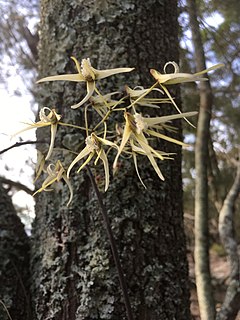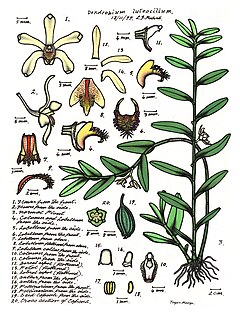
Dendrobium teretifolium, commonly known as the thin pencil orchid, rat's tail orchid or bridal veil orchid, is an epiphytic or lithophytic orchid in the family Orchidaceae. It has long, thin hanging stems, pencil-like leaves and rigid flowering stems bearing up to twelve crowded white to cream-coloured flowers. It grows in rainforest and humid open forest mostly in near-coastal districts in New South Wales and Queensland.

Dendrobium discolor, commonly known as antler orchids, are epiphytic or lithophytic orchids in the family Orchidaceae. They have cylindrical pseudobulbs, each with between ten and thirty five leathery leaves, and flowering stems with up to forty mostly brownish or greenish flowers with wavy and twisted sepals and petals. Antler orchids occur in northern Australia, New Guinea and Indonesia and there are several subspecies and varieties.

Dendrobium gracilicaule, commonly known as the blotched cane orchid or yellow cane orchid, is an epiphytic or lithophytic orchid in the family Orchidaceae. It has cylindrical pseudobulbs, between three and seven thin leaves and up to thirty often drooping, cream-coloured to yellow or greenish flowers, sometimes with reddish brown blotches on the back. There are two varieties, one occurring in Queensland and New South Wales and the other on some Pacific Islands, including Lord Howe Island.

Dendrobium moorei, commonly known as the drooping cane orchid, is a species of epiphytic or lithophytic orchid in the family Orchidaceae and is endemic to Lord Howe Island. It has cylindrical pseudobulbs, leathery, dark green leaves and between two and fifteen small, white drooping flowers that do not open widely.

Dendrobium agrostophyllum, the buttercup orchid, is an epiphytic or lithophytic orchid in the family Orchidaceae and has a creeping rhizome with well-spaced pseudobulbs. Each pseudobulb has up to twenty grass-like leaves, some of the leaves having flowering stems on the opposite side of the pseudobulb, each raceme with up to ten waxy, fragrant, bright yellow flowers. It grows in wet forest in coast areas of north Queensland, Australia.

Dendrobium baileyi, commonly known as the blotched gemini orchid, is an epiphytic or lithophytic orchid in the family Orchidaceae and has arching stems and flowering stems with one or two spidery, yellow flowers with dark purple spots emerging from leaf axis. It grows in tropical North Queensland, New Guinea and the Solomon Islands.
Dendrobium fellowsii, commonly known as the native damsel orchid, is an epiphytic or lithophytic orchid in the family Orchidaceae and has upright pseudobulbs, up to five leaves and groups of up to five pale green or yellowish flowers with a deep purple labellum. It grows in tropical North Queensland.

Dendrobium schoeninum, commonly known as the common pencil orchid, is an epiphytic or sometimes a lithophytic orchid in the family Orchidaceae and has thin wiry, upright or pendent stems with fleshy, grooved, dark green leaves. Its short flowering stems have one or two, rarely up to four pale green, cream-coloured or mauve flowers with purple markings on the labellum. It grows on rainforest margins in coastal New South Wales and southern Queensland.

Dendrobium bifalce, commonly known as the native bee orchid, is an epiphytic or lithophytic orchid in the family Orchidaceae. It has spindle-shaped pseudobulbs with up to four leathery leaves and up to ten pale green or greenish yellow flowers with purplish markings. It grows on trees and boulders in rainforest in tropical North Queensland, Australia and in New Guinea.

Dendrobium bowmanii, commonly known as the straggly pencil orchid, is an epiphytic or lithophytic orchid in the family Orchidaceae. It has thin wiry, straggly stems with a small number of small leaves and up to four greenish or brownish flowers with a conspicuous white labellum. It grows in drier rainforests and coastal scrub in New South Wales, southern Queensland and New Caledonia.

Dendrobium canaliculatum, commonly known as the brown tea tree orchid or thin tea tree orchid, is an epiphytic or lithophytic orchid in the family Orchidaceae. It has cone-shaped or onion-shaped pseudobulbs, up to six deeply channelled, dark green leaves and up to thirty star-shaped, light brown to caramel-coloured white or greenish to apricot-coloured flowers with darker tips. It grows in tropical North Queensland and New Guinea.

Dendrobium cancroides, commonly known as the crab orchid, is an epiphytic or lithophytic orchid in the family Orchidaceae. It has long, narrow, flattened stems with up to fourteen leaves in the upper half and one or two star-shaped reddish brown flowers with a yellow centre. It grows in rainforest, often in trees overhanging streams in tropical North Queensland.

Dendrobium finniganense, commonly known as the Mount Finnigan cane orchid, is a species of terrestrial or lithophytic orchid endemic to a few mountain tops in far north Queensland, Australia. It has narrow, cylindrical pseudobulbs, each with up to three thin, dark green leaves and usually only one or two white to cream-coloured flowers with yellow and purple markings near the centre.

Dendrobium fleckeri, commonly known as the apricot cane orchid, is a species of epiphytic or lithophytic orchid endemic to far north Queensland, Australia. It has cylindrical pseudobulbs with two or three dark green leaves and up to four apricot-coloured or yellowish green flowers with tangled white hairs on the edge of the labellum.

Dendrobium pruinosum, commonly known as the honey orchid, is an epiphytic or lithophytic orchid in the family Orchidaceae and has flattened, yellowish stems and pairs of cream coloured, dull yellow or greenish flowers. It grows in tropical North Queensland and New Guinea.

Dendrobium racemosum, commonly known as the erect pencil orchid, is a species of orchid endemic to tropical North Queensland. It is an epiphytic or lithophytic orchid with yellowish stems, cylindrical dark green leaves and flowering stems with between eight and fifteen cream-coloured to pale yellow flowers with a thread-like tip on the labellum. It grows on trees and rocks in exposed positions in highland areas and in the tops of rainforest trees at lower altitudes.

Dendrobium tozerense, commonly known as the white gemini orchid, is an epiphytic or lithophytic orchid in the family Orchidaceae. It has thin, wiry stems, stiff leaves and pairs of star-shaped, white flowers. It grows in rainforest in tropical North Queensland, Australia.
Dendrobium clementsii, commonly known as the Cape York crimp orchid, is a species of epiphytic or lithophytic orchid that is endemic to tropical North Queensland, Australia. It has long stems, tapering pseudobulbs each with a thin, leathery dark green leaf and clusters of short-lived, cream-coloured flowers with a purple labellum.

Dendrobium malbrownii, commonly known as the McIlwraith hermit orchid, is an epiphytic or lithophytic orchid in the family Orchidaceae and is endemic to tropical North Queensland, Australia. It has thin, wiry, crowded stems each with narrow, dark green leaves and a single shiny, cream-coloured flower with a purple labellum. It grows on trees, fallen logs and rocks in rainforest on the McIlwraith Range.
Dendrobium deuteroeburneum, commonly known as the rainforest feather orchid, is a species of epiphytic or lithophytic orchid that is endemic to eastern Australia. Its pseudobulbs are cylindrical, pressed against the host tree or rock and have one or two leathery, dark green leaves and up to seven pale greenish cream-coloured flowers with purple markings on the labellum.
















